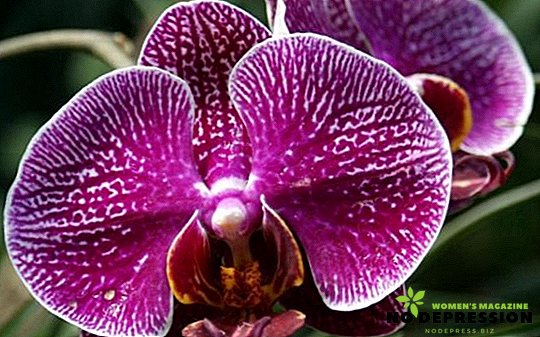Many when growing orchids have dozens of questions on the care of this plant, because this flower is quite fastidious. Therefore, it is important to know for what reason this plant stops blooming and how to solve this problem.

When and how long does an orchid bloom?
Many beginner flower growers and indoor plant lovers often alarm in vain if the orchid does not bloom. It is important to know the biological rhythm of this plant and rely on it during flower care. For example, if a flower has only been planted, then the first flowers will appear in a year or two.
The whole process of plant growth can be divided into the following steps:
- Orchids after planting in the ground begin to develop instantly. However, it takes at least six months to strengthen the root system.
- Next, the leaves, roots, and stem of the plant begin to develop. The development of these parts of the orchid speaks of their normal growth. As soon as the first leaves appear, it is necessary to closely monitor the flower. During this period, the green mass is formed, the buds of the peduncle are born. Further blooming of the plant depends on their quality.
Care during the formation of the buds of the peduncle is the correct feeding of the flower. As a fertilizer for orchids, you can use store-bought mixes. But it is important to remember that some types of orchids, such as Phalaenopsis, require a lot of potassium, phosphorus, magnesium, but with a minimum of nitrogen. Thus, potash fertilizers are best suited.
Also, many are interested in the timing of flowering of this plant.
An exact answer can not be given, because each variety has its own mode, which adapts to the conditions of the area.
Thus, temperature drops, the amount of sunlight, watering can significantly change the timing of flowering. In most cases, the adult plant blooms once a year, so the flowering time is up to 3 months.
Although there are several varieties that bloom in summer, and the end of flowering occurs in early spring. There are varieties that bloom two or three times a year. But if the orchid refuses to bloom during the year, then this is a clear abnormality. To solve a problem, you must first find the reason why the plant does not bloom. There can be many reasons, below we will analyze why the orchid does not bloom.
Care errors
The main reasons that lead to the lack of flowering are improper care. Neither the time of the year, nor the temperature outside the window matters; only the microclimate that is created inside the room and compliance with the care recommendations are important. To say exactly why the orchid does not let out the peduncle is very difficult. Here it is necessary to analyze all the parameters, measure the day and night temperatures, determine the level of humidity. Below are the main mistakes in the care of an orchid.
Temperature
Temperature is a very important aspect that affects orchid bloom. Thus, for flowering this plant requires heat and light. If orchids can winter at 8 degrees, the temperature should be much higher for flowering. Of course, the recommended temperature for different species of this plant is different, but on average for the flowering phase of any orchid you need at least + 20 ... +25 degrees. It is extremely important that the flower remained in the shade. It should not be exposed to the sun, as burns may remain on the plant.
Lighting
 This is the second most important criterion by which it is also possible to determine the quality of living conditions for a flower. Thus, the duration of daylight should be at least 12-14 hours. Orchids in this case can not be put under the open sunlight.
This is the second most important criterion by which it is also possible to determine the quality of living conditions for a flower. Thus, the duration of daylight should be at least 12-14 hours. Orchids in this case can not be put under the open sunlight.
This can cause burns or overheat the plant. Behind glass in the sun, a thermometer can show more than +35 degrees; at the same time, orchids cannot stand the heat above +32 degrees.
Therefore, the lighting should be bright, abundant, but at the same time diffused. It is best to put a container with an orchid in the north-west, west or north window. With a short light day during the winter period, most varieties of orchids need additional artificial lighting for flowering. To do this, you can buy phytolamp or ordinary desk fluorescent light.
Watering
Every florist should know how to properly water these plants so that the orchid is healthy. The root system of such flowers is very unusual. Thus, these plants do not grow on the ground where trees grow, there are rocks. It is for this reason that their root system is unusual. Orchid roots in the literal sense of the word feed on the air. From him they get the necessary amount of moisture and nutrients.
To achieve flowering orchids, it is necessary to strictly follow all recommendations for watering. First of all, it is moderation. It may seem strange to some, but by reducing the watering you can get the desired peduncle. Everything rests on the particular structure of the root system. Orchid roots should not be in the water, they do not tolerate stagnant moisture. With frequent or excessive watering moisture does not have time to evaporate, which can cause rotting of the root system. To understand the seriousness of the situation, imagine that the roots of an orchid, if placed in water, will rot completely in just two days.
Why doesn't the orchid bloom after transplanting?
Transplanting is a mandatory procedure for these plants, which is due to the fragility of the substrate. Over time, it loses its properties, nutritional value approaches zero, the structure is destroyed. As a rule, you need to replant orchids every two years. Usually work is carried out in a dormant period after flowering. In most cases, this has a positive effect on the plant. But it happens that after the transplant the orchid stops blooming.
Root system disrupted
 The most common causes of lack of flowering are mechanical disturbances of the root system, that is, improper pruning or breaking of healthy roots.
The most common causes of lack of flowering are mechanical disturbances of the root system, that is, improper pruning or breaking of healthy roots.
To avoid this, you need to take the transplant seriously. Be sure to process all cuts, carefully handle the roots, which do not require pruning.
Violation of the root system can cause a fading of the development of the orchid and, as a result, the lack of flowering until the flower is fully restored. This process can take up to six months.
Maintain flower stability
Orchid substrate is used not only for nutrition, but also as a support. If there is no flowering, but you are sure that you have provided the plant with all the necessary conditions, then be sure to check how stable the plant is in the ground. It is very easy to do this: try to gently move the barrel in the pot - if it grows tight, you shouldn’t sway.
How to make orchids bloom
There are many methods to stimulate flowering. However, not all of them are effective and useful. You need to choose the most suitable option depending on the situation and the reason. Using a good stimulant, you can get several flower stalks at once.
Chemical processing
To make the plant blossom, you can use some simple preparations that are sold in any garden store. They are specially created in order to stimulate and accelerate the growth, development and flowering of this flower. If used properly, they will not do any harm to the orchid, but will only improve its health. The most famous drugs are Epin and Amber Acid.
Such drugs have a similar effect. In addition to stimulating growth, they enhance immunity, improve the appearance and condition of the plant root system. It is possible to process an orchid with these preparations using either a spraying method or an irrigation method, while it is very important to follow the instructions for use clearly.

Temperature difference
Temperature drop can be used to deceive the flower. Reception is simple, but very effective. It is necessary to gradually reduce the temperature in the room to + 17 ... +18 degrees for two days.
Then you must leave the flower for about a half to two weeks at this temperature. Also during this period it is important not to water the orchid, since watering is contraindicated in such cool weather. After the specified time it is necessary to raise the temperature to 25 degrees, but it should be done smoothly, gradually over several days. For the plant it will be a signal that the dormant period has ended and it is time to enter the flowering phase.
Watering restriction
In the tropical jungle there are rainy seasons. It is at this time that orchids bloom most often. As a rule, the dry season precedes the rainy season. It is on such a natural memory that you can play. Just stop watering the flower. At the same time, do not be afraid to harm the plant, because drought for orchids is not so terrible as watering too often.
Extend artificial drought to 3-4 weeks, then resume watering. For a flower, this will be the beginning of the flowering season. True, this method can be reused only after a year. Also remember that this option is only suitable for a healthy plant.
Pruning
This method is used when the plant already has a flower stalk, but at the same time the orchid has stopped blooming and new buds do not appear on the plant for a long period. It is enough just to trim a part of the peduncle 12 cm above the bud.












